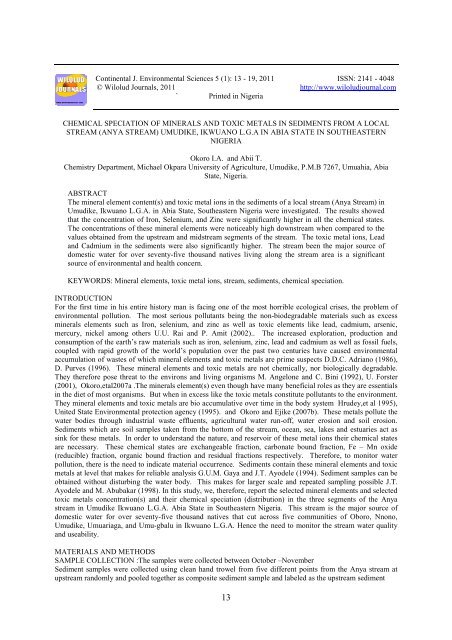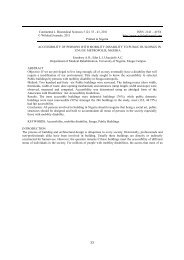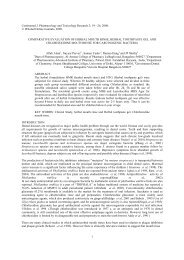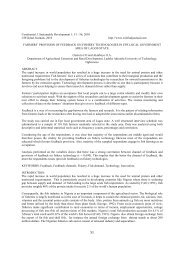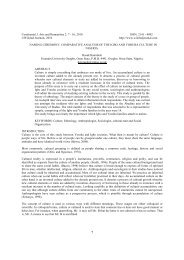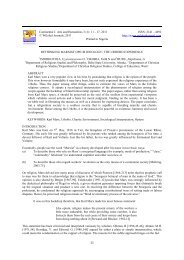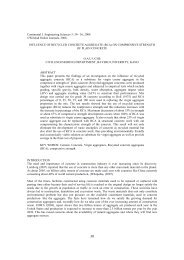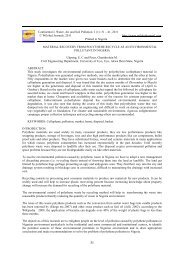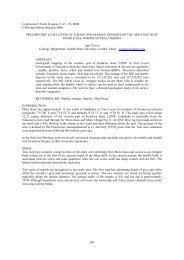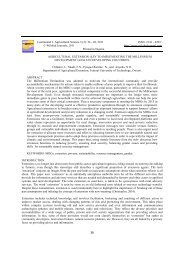Vol 5 _1_ - Cont. J. Environ. Sci. - Wilolud Journals
Vol 5 _1_ - Cont. J. Environ. Sci. - Wilolud Journals
Vol 5 _1_ - Cont. J. Environ. Sci. - Wilolud Journals
You also want an ePaper? Increase the reach of your titles
YUMPU automatically turns print PDFs into web optimized ePapers that Google loves.
Okoro I.A. and Abii T: <strong>Cont</strong>inental J. <strong>Environ</strong>mental <strong>Sci</strong>ences 5 (1): 13 - 19, 2011of cadmium in this fraction in high concentration downstream makes cadmium less available that could pose athreat to water quality of this local stream.The mobility factor calculated for Iron, Selenium, Zinc, Lead and Calcium in the sediments of Anya stream asreported in Tables 1 and 2 was obtained using the equation below:MF = F 1 + F 2 /(F 1 + F 2 + F 3 + F 4 + F 5 ) * 100 (1)Where;F 1 is the exchangeable metal fractionF 2 is the carbonate bound metal fractionF 3 is the Fe – Mn oxide called the reducible metal fractionF 4 is the organic bound metal fractionF 5 is the residual metal fraction.Equation 1 because the mobility of metals in sediments may be expressed based on absolute and relativecontent(s) of the fractions weakly bound to sediment components. The relative index of Iron, selenium, zinc,lead and cadmium in the sediments from the Anya – stream was calculated as the mobility factor using equation1 as reported in Table 3 (Terus (1995), Ahumada et al, (1999) and Karezewska (1996)). A high MF value for ametal in the sediments is an indication of high lability and biological availability (Ahumada, et al (1999), A.Karezewska (1996), Ma et al 1997), Narwal et al, (1999), Kabia et al(2001)).From table 3, the trend in the mobility factor value for lead and cadmium was MS > DS > NS and US > DS >US respectively. Anya stream is a cause for environmental concern as this is an indication of toxicity of thismetal due to its bioavailability for uptake by aquatic organisms, plants and ingestion by local natives as thestream is the local source of water for cooking, laundry and irrigation (Kabia et al (2001), Salibu et al, (1998)).CONCLUSIONThe combination of chemical speciation and mobility factor is a useful analytical tool for predicting the degreeof contamination of sediments of any stream, river. When the Iron, Selenium, Zinc, Lead and Cadmium level inthe sediments of Anya stream is compared values obtained by other researchers, stream is not polluted.These findings are in agreement with the anthropogenic activities, going on along this Anya stream as thestream flow through the serene environments of the National Root Crop Research Institute and the FederalUniversity of Agriculture, Umudike in Ikwuano L.G.A in Abia State in the South-eastern Nigerian.ACKNOWLEDGEMENTWe acknowledge the assistance given to us by Rivers State <strong>Sci</strong>ence and Technology Department by makingavailable to us the AAS instrument.REFERENCESAdriano D.D.C. (1986). Trace element in Terrestrial <strong>Environ</strong>ment, Springer – Verlag New York. Pp 10 – 12.Ayodele J T and Abubakar M(1998). Trace element contamination of rain water in semi-arid region of KanoNigeria, <strong>Environ</strong>s, Man and Health, 9, 174-196Angelone M and Bini C (1992). Trace Element concentration in soils and plants of Western Europe, in D.C.Adriano (ed), Biogeochemistry of trace elements, Press Boca Raton fl, pp 19 – hazards, 2, 1 – 5.Ahumada I, . Mendoza Jand . Ascar L (1999). Sequential extraction in soil irrigation with waste water,Communication in Soil <strong>Sci</strong>ence and plant Analysis, 30, 1057-1519..Brandy N C (1994). Radionuclide, the nature and properties of soil, Macmillan Publishers New York, Pp 570 –572.Barbara F. Stephen K K and William W (2002). Speciation and characterisation of heavy metals contaminationsoil using computer-controlled scanning electron microscope <strong>Environ</strong>mental forensic 3,131-143.17
Okoro I.A. and Abii T: <strong>Cont</strong>inental J. <strong>Environ</strong>mental <strong>Sci</strong>ences 5 (1): 13 - 19, 2011Carol S O, Day P A. Esser B and Randall S. (2002). Speciation and trace metals in estuarine sediments underreduced and oxidized conditions, seaplane, lagoon, Alameda Naval Air station (USA), Geochemical Trans,3(10), 81-101Duffus H (2001). Heavy Metals Toxicology, Chemical International India, 23 (6), 11-16.Forster U (2001). Land <strong>Cont</strong>amination by Metals – Global Scope and Magnitude of Problems, in H.E. Allen etal (ed), Metal Speciaiton and <strong>Cont</strong>amination of Soil, CRC Pres Boca Raton fl, pp 1 – 34.Gaya G U M and Ayodele J T (1994). Determination of lead in street dust to Index Pollution in Kanomunicipal, Spectrum J,I, 91-92.Graham D R and Stangoulis J C(2003). Trace element uptake and distribution in Plants. Crit Rev. Plant. <strong>Sci</strong>.,14,49-52.Garcia M J Band . Sosa M S (1994). Trace Metals in Valencia lake (Venezuela) Sediments, Water Air andSoils, International Journal of <strong>Environ</strong>mental pollution, 77, 141 – 149.Hrudey, S E Chen W and , Rousseaux CG (1995). Bioavailability in <strong>Environ</strong>mental Risk Assessment, LewisPub. Boca Raton Fl, pp 50 – 74.Kabia C andSingh B R(2001). Fractionation and mobility of Copper, Lead and Zinc in Soil profileapproximately a Copper Smelter communication in Soil <strong>Sci</strong>ence and Plant Analysis. 30, 485 – 495.Karezewska A(1996). Metal Species distribution in top and sub soil in an area affected by smelter emission,Applied Geochemistry, 11, 35 – 42.Ma I Q and Rao G N and (1997). Chemical Fractionation of Cd, Cu, Ni, and Zn contaminated soils.<strong>Journals</strong> of Evironmental Quality, 26,259, 264.Narwal R P, Singh B R and Salibu B (1999). Association of Cadmium, Zinc, Copper and Nickel withcomponents in naturally heavy metal rich soils studied byparallel and sequential extraction, communication in soil science and Plant Analysis 30, 1209 – 1230.Okoro I A, Oriaku C I and Ejike E N (2007a). Lead Characterisation Street dust in some cities in SoutheasternNigeria, Research J. of Applied <strong>Sci</strong>ences, 2(1)39-42.Okoro I A and Ejike E.N. (2007b). Sorption Models of Pb (11) removal from Aqueous Solution using commonedible fruit wastes, European J of scientific research. <strong>Vol</strong> 17 No 2, 270 – 276.Petya k, Rumiana Dand Irvelin K (2000). The representative smpling of plants for multi elements analysis,Photo logia Bcteria. 6(1), 91-102Purves D (1996). Trace Element <strong>Cont</strong>amination of <strong>Environ</strong>ment, Elsevier, Amsterdam, Quanta chromecorporation, Nova 1200, gas sorption analyser manual, pp 11 – 27.Par do M T (2002). Sorption of Lead, Copper, Zinc and Cadmium by soils, effects of nitro acetic acid on metalretention, commune. Plant Anal. 31,31-40.Rai U U and Amit P(2002). Health Hazards of Heavy Metals. J. or environmentalPress Boca Raton fl, pp 19 – hazards, 2, 1 – 5.. Salibu B, Kreling T and Oungton D J (1998). Characterisation of Radioactive Particles in the environment,Analyst, 123, 843 – 849.Tessier A Campbell P G and . Bison M(1979). Sequential extraction Procedures for the speciation ofparticulate trace metal. Anal. Chem, 5, 1844 – 1851.18
Okoro I.A. and Abii T: <strong>Cont</strong>inental J. <strong>Environ</strong>mental <strong>Sci</strong>ences 5 (1): 13 - 19, 2011Terus (1995) A. Distribution of differential fractions of Cd, Zn, Pb and Cu in unpolluted and polluted soils,Water, Air and Soils Pollution, 83:1-4.United State environmental protection agency (1995). Test Methods for evaluating solid wastes <strong>Vol</strong> 1A,laboratory manual, physical and chemical methods SW846 3 rd Ed U. Washington gov. print office D.C., PP 1 –25Received for Publication: 24/04/2011Accepted for Publication: 28/06/2011Corresponding AuthorOkoro I.AChemistry Department, Michael Okpara University of Agriculture, Umudike, P.M.B 7267, Umuahia, AbiaState, Nigeria.19


